How To Make A Referral
One of the basic tenets of customer success is using your service to create advocates for your business. An army of satisfied customers can do a lot of legwork for you. In fact, customers rely on word-of-mouth between two and 10 times more than paid media, and 74% of consumers say recommendations from people they know are key drivers of their purchasing decisions. Not sure how to create the conditions for these consumer connections? Start with a customer referral program. Here's what you need to know about building, expanding, and managing a program that works. Customer referrals are highly valuable because they don't cost much — if anything — to acquire. The exact value of a referral varies across different businesses, but it's roughly the lifetime value (LTV) of a customer, plus the cost of customer acquisition (CAC), which you can then use to acquire additional customers. Data tells the tale: Companies found that referred customers are 18% more loyal, have a 16% higher lifetime value rate, and spend 13% more than their non-referred counterparts. What's more, the market is growing. Referrals grew by 425% during the first wave of lockdown as companies looked for ways to expand their customer base even as sales, marketing and purchasing moved online. And these programs work — 86% of companies with robust referral strategies have seen revenue growth over two years. The reality is, however, that you're effectively asking your customers to stand in place of your marketing and sales departments. And when referrals are the heart of generating new business, operating with tact, consistency, and patience is extremely important. A referral program is a word-of-mouth marketing tactic that encourages customers to advocate on behalf of your brand. Rather than writing reviews online, or submitting customer feedback surveys, referral programs let customers share their brand experience with partners, colleagues, and friends. The purpose of a referral program is to attract new leads to your business. But, you're not just bringing in anyone. By asking customers to think about people who would benefit from your product or service, they'll refer leads that are a good fit for your brand. This only makes it easier for your marketing and sales teams to nurture and engage customers because not only are these leads a good match for your business, but they're also familiar with your company and its reputation. Since they've been referred by someone they know, they have a reliable resource telling them that your company is trustworthy and produces a positive customer experience. If you're ready to start leveraging word-of-mouth at your business, read on to the next section for tips on how to create a customer referral program. These free customer referral templates can be used for creating a bank of: Ask yourself: what do you hope to get out of this referral program? Are your goals tied more to growth and revenue? Do you want to add retention to that mix? Are you in an industry that requires an exceptional amount of trust-building? Once you decide what your goals are — and explicitly define them — the next steps should lay themselves out for you. A good place to start is by assessing where and how referrals are coming to your business — or if they're coming to your business at all. This is where you should involve marketing, sales management, support — anyone who would be responsible for building customer relationships — and assess how they've been traditionally dealing with referrals. This will give you an idea of where you already are. You should also know what an existing customer is worth. Compared to time spent monitoring and managing onboarding programs, how many referrals do you need to break even? On average, referred customers' lifetime value is 16% more than that of non-referred customers, so it's worth doing the math to see how much referrals could generate and adjusting your marketing spend accordingly. Before you tell customers to seek out referrals, you should first identify what an ideal customer looks like. That way, your existing customers will refer leads that actually buy from your business, rather than just listing names to collect the program's incentive. These descriptions should be placed right at the forefront of your customer referral program. For example, if you have a form that customers fill out, you should describe what a "good fit" customer is right at the top of the form. This will remind participants that you're looking for specific individuals who need your product — not just a friend who might be interested in your business. We'll call these advocates, and they can be anyone whom you're already connected to currently, or who you have been connected to in the past. Begin listing them out. This list could include current customers, past customers, leads that may not have closed, industry leaders, your vendors, etc. This will give you a solid footing to start with. For your referral program to work, you'll need a communication platform that alerts both your business and the referred customer when a referral is submitted. Here's an example from Uber, where the customer can share a Facebook message with the person that they want to refer to. Image Source When this ride credit is sent, not only does the referred customer get the message, but Uber knows the original customer submitted the referral. Uber can now turn to its marketing and sales teams to further engage the referred customer as soon as they sign up using the ride credit. While you don't have to offer a $20 discount, your business should provide customers with a way to share their referrals. That way, the introduction to your company is through a trusted peer rather than your company contacting them completely out of the blue. Now, refine. Narrow down the list of advocates and sources to a list of "inner circle" contacts. These are people who know what value your business has and would refer you without any incentive. Finding your inner circle isn't a process that can be automated — you'll get more benefit from this if you pull and segment these contacts manually. Once you have your inner circle segmented out, you now have two things to take into consideration. First, timing is everything. Identify appropriate times to ask these inner circle advocates to take part in your referral program. Because they are people you've worked with before, this is a less strenuous process. When you start working with people who will need an incentive (which we talk about below), it's important to consider the relationship. For some companies, depending on the service or product, asking for a referral needs to happen late in the relationship. For others, it could be upon the first sale (think apps, digital interface services). Then, once you've asked, wait some more. That might require a waiting period of months, or even a year, to remind them about the referral program again. Additionally, you should also be picky with your advocates (even your inner circle ones). Identify people whom you think could market your brand the way that it should be marketed. Within that inner circle, who do you have a stellar, standout relationship with? Or do you have an existing customer that came from a referral and worked out? And remember: Watch out for referral fatigue, and make sure you're not overburdening your contacts. There are two options for a referral program: an incentive and a non-incentive program. During this step, you should break your contacts out by levels and decide which ones can receive which offer. And don't forget the referrer — make sure they get something out of the deal, too. Take Airbnb for example: when a customer refers a friend, they get $20 credit — and when a customer first signs up, they get a credit towards their first trip over a certain amount. Once you have a referral program, create resources you think would work well, and alert your customers. Then, promote, promote, promote. And consider multiple avenues of promotion beyond the time-limited email campaign to remind your customers of the program's existence. Those might look like: Once you have the referral programs outlined, you'll have an idea of what resources you need for each one. I've listed out a few resources you might need below: Whatever your medium, make sure it's consistent, persistent (though not over-the-top), and in line with your program's revenue, growth, and retention goals. Regardless of the size of your company (though this is especially relevant if your company has a larger customer base) you need to have tracking set in place. This will ensure that you don't miss one detail — for referred accounts especially. You should be tracking: If you don't already invest in a CRM (customer relationship management) system, then now is a great time to become familiar! Keeping track of customer relationships is a huge component of customer success — the ability to individualize each account or relationship makes each customer feel like they're a unique part of your base. Thank the referrer for helping you out (this is where incentives might work, but also consider messaging that thanks them specifically as well) and thank the referred for joining. Then, get to work — you've got happy customers to prove right. When you do land a solid lead, be sure to take advantage of it right away. Don't let your referrals sit around for too long or you might miss the opportunity to secure these new customers. Remember, while your customer may have referred this person to your business, they may have referred them to other companies as well. What's more, you don't know what research the referred customer has done on their own, and you may have to swing them away from going with a competitor that they've been considering for some time. At the end of the day, the sooner you can make your impression, the more likely you'll be to close the deal. As we mentioned earlier, there's no universal blueprint for creating a perfect customer referral program. The best program for your business will be unique and potentially quite different from your competitors depending on how you assess customer needs and preferences. The important takeaway here is that it may take some time to figure out what works and what doesn't — and that's perfectly normal. You should be testing your program regularly to see what you're doing well and where you can stand to improve. Try sending your customers feedback surveys to see what they think about your program and be sure to apply that feedback moving forward. After all, the better your referral program is, the more leads it will generate for your marketing and sales teams. Now that we've explained how to create a referral program, let's explore some ways you can put this plan into action. Contests or giveaways can incentivize customers to refer new leads. For example, you can host a contest where customers are only entered if they refer a certain number of leads to your business. This can mean providing a list of emails or getting signups for a free trial or membership. The one risk that you run with contests is the quality of leads. If customers are randomly selecting their peers, you might not obtain leads who are interested in your business. This will cost your marketing and sales team time as they sort contacts who aren't a good fit for your company. Be sure to create contests that encourage customers to refer high-quality leads. You can do this by basing your entry fees on conversions rather than referrals. If a customer wants to be entered into the contest, they need to get people to sign up for or purchase your product, rather than simply providing an email. This will ensure that you're rewarding customers for providing high-quality leads to your business. It's easier to motivate customers if they don't feel like you're trying to manipulate them. When you send out a coupon that says, "refer five people and get 25% off," customers know that you're trying to get something from them and are more dubious of your offer. Instead, you can leverage social gifting as a way to encourage referrals without directly asking for them. Take the example below. Image Source Instead of rewarding customers for providing a certain number of referrals, this offer rewards them for sharing a coupon with their peers. This way, the customer not only gets to give a gift to a friend but is also rewarded each time their referrals redeem the coupon. That provides them with extra incentive to reach out to as many people as possible. Fundraisers are a great way to connect with your customers' values in a way that doesn't involve your product or service. By getting involved with a cause that your customers care about, you're demonstrating that you understand more than just their buying habits. You recognize their personal values as well as what they are looking for from your business. Additionally, fundraisers present a referral opportunity as well. It's easy for customers to share fundraisers with their peers, and as more people donate and participate, your team will build a database of leads who share the same values as your company. This makes it more natural for your business to follow up with these new leads and shift the conversation towards your products and services. So far, we've discussed referral program ideas that encourage one-time referrals. While these are certainly effective, it's tough to host a daily contest or start a fundraiser every other week. Instead, it's more efficient to have a referral program that motivates customers to refer multiple people over a long period of time. To accomplish this, you can create customer loyalty tiers that reward people as they continue to refer leads. Each tier has unique benefits and when customers refer a specific number of leads, they're promoted into the next loyalty tier. With this setup, customers are constantly motivated to refer new leads even if you're not hosting a contest or promotion. Seasonal campaigns are always a timely way to draw in new customers. You can promote holiday discounts, annual sales, and long-term deals that can be used every year. And, if you execute these campaigns consistently, your customers will look forward to them year-round. Customers like to feel like they're a part of a community, especially if it's exclusive. By hosting events that are reserved for members of your customer loyalty program, you can capitalize on customer advocacy and attract new leads. For example, you can provide extra tickets to an event so customers can invite their peers and introduce them to your brand through a casual setting. Rather than bringing them into one of your stores, leads can attend a company outing or event where there's no pressure to close a deal. If your customers are looking for a more direct return on their referrals, you can also offer them discounts based on how many leads they bring to your business. Remember, acquiring a new customer is much more expensive than retaining an existing one, so the money you lose on the discount will be made up for with the leads that you convert. Product or service upgrades are excellent incentives for customer referral programs because they both attract new leads and they encourage existing customers to continue using your products. If you don't have an upgraded product or service to offer, you can instead introduce customers to beta features, products, and services that the rest of your customer base doesn't have. Not only will this "wow" customers with what your product development team has been working on, but it will also make them feel like part of an exclusive group that has VIP access to these special features. With this approach, you're not just offering an incentive in return for new leads. You're encouraging customers to share positive feedback while simultaneously adding value to their customer experience over time. Here, you're helping yourself by helping your community. Instead of rewarding customers with discounts or exclusive events, you partner with a local charity organization and make a donation every time an existing customer provides a new lead referral. This is particularly useful to help build brand reputation and trustworthiness over time — both of which are now a priority for consumers. Who doesn't love a gift? And while picking your own from a lineup of potential presents is great, sometimes it's even better to get a surprise. This is the idea behind mystery gift referrals — when current customers refer potential prospects, you send them a mystery gift. It doesn't need to be anything extravagant, just something that shows your appreciation. If you're still not sure how to use these strategies, let's look at a few companies that have successfully executed these customer referral ideas. Dropbox offers free products or services in exchange for users referring new customers: You can earn more cloud storage space in exchange for referring a friend. Image Source When you refer a friend to Acorns, an online micro-investing service, you get $5 deposited in your account when they start investing. It's called Acorns because it's all about investing small amounts of money to accumulate wealth, so $5 goes a long way. Sometimes, people just want money — but especially if they're already using a money management app. Image Source When you refer a friend to Stitch Fix, an online styling and shopping service, you get a credit on your next order. The amount of the credit varies, so be sure to check your account's Referrals page to see how much you can earn. It's an easy step to go from telling someone where you got your outfit to sending them a link to try it themselves, so pairing that with a compelling credit or discount makes this program successful. Image Source Customers who refer cellular carrier T-Mobile to their friends can earn up to $50 per friend who purchases a T-Mobile plan and up to $500 per year. Friends, meanwhile, enjoy discounts on their new plans to help encourage the referral process. Image Source Makeup and skincare brand Glossier's referral program is similar to Stitch Fix's but is helpful to encourage first-time or one-time purchases, too. Glossier offers mutual rewards for referring friends that gifts both people with credits toward their next haul. It even has a nifty button that lets you gently remind your friend about the offer three days later. Image Source Healthy Paws pet insurance has a referral program that donates $25 to homeless pets on behalf of referrers when referrals are completed. It's a smart choice to offer this type of referral for an animal-focused insurance business — the compassionate nature of the reward is likely to attract both current clients and new customers alike. Image Source Online underwear company MeUndies offers a win-win situation for customers who like their product: New buyers get 20% off their first order, and existing customers get $20 off their next order. Here's how it works: Customers with an active account and at least one purchase can generate a referral link and send it to friends. When friends use the link to make a purchase the 20% discount is automatically applied and existing customers get a $20 credit on their account. Simple? You bet. Effective? Absolutely. Image Source Search giant Google also has a referral program that offers cold, hard cash for bringing new users into the fold. Existing Google Workspace customers simply sign up and get their referral link which they send to friends or colleagues. Unlike many other programs, however, Google doesn't bother with discounts or free gifts — if new customers use referral links, referring customers can earn up to $23deposited directly into their bank account. Image Source Renewable products manufacturer Tesla is betting that its customers are willing to refer friends and family even on high-value items such as Solar Roof and Solar Panels. Using their custom-generated referral link, customers who share with friends that make a purchase get $500 for each roof referral and $300 for each panel referral, while new customers get the same in discounts off their new solar purchases. Image Source Food delivery company Doordash is always looking for new drivers, and their referral program is designed to target areas where demand is highest. Current drivers can check their app to see if drivers are needed in their area — if so, they'll see a "Refer Friends" banner at the top of their screen. They can then send referral links to friends looking to become DoorDash drivers — when these new drivers complete the required number of deliveries, both referrer and referee can earn cash bonuses. Worth noting? The amount earned scales with current demand. In high-demand areas, new "Dashers" and those who refer them could earn up to $1,000. Current drivers can also refer up to 15 new drivers. Image Source Overall, a customer referral program is a great way to retain customers and drive word-of-mouth marketing. Creating advocates for your company will keep the flywheel spinning. Editor's note: This post was originally published in June 2021 and has been updated for comprehensiveness. 
How valuable is a referral?
What exactly is a referral program?
How to Create a Customer Referral Program
1. Start with customer referral templates.
 Whether you're a one-person customer referral machine or part of a multi-person referral team, templates are a huge help in the process. They can be adjusted to fit the voice and tone of your brand and utilized by anyone in the company that needs them.
Whether you're a one-person customer referral machine or part of a multi-person referral team, templates are a huge help in the process. They can be adjusted to fit the voice and tone of your brand and utilized by anyone in the company that needs them.
2. Set your goals.
3. Research how referrals are coming to your business.
4. Determine what a 'Good Fit' customer is for your company.
5. List your possible referral sources.
6. Identify channels to host your referral program.
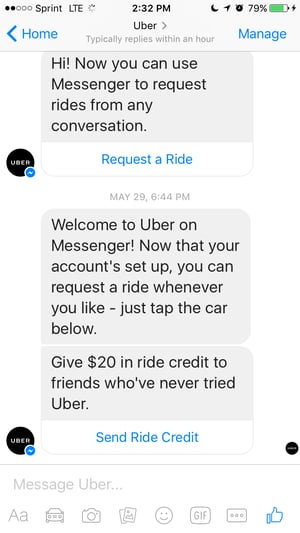
7. Make a plan to reach out.
8. Identify your incentives.
9. Create resources to alert your customers.
10. Set up tracking.
11. Say "Thank You."
12. Follow Up on Your Referrals Quickly.
13. Improve your referral program.
Customer Referral Program Ideas
1. Contests or Giveaways
2. Social Gifting
3. Fundraisers
4. Customer Loyalty Tiers
5. Seasonal Campaigns
6. Exclusive Events
7. Referral Discounts
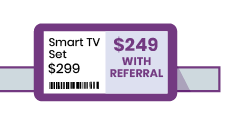 Image Source
Image Source 8. Product or Service Upgrades
9. Charity connections
10. Mystery Gifts
Customer Referral Program Examples
1. Dropbox
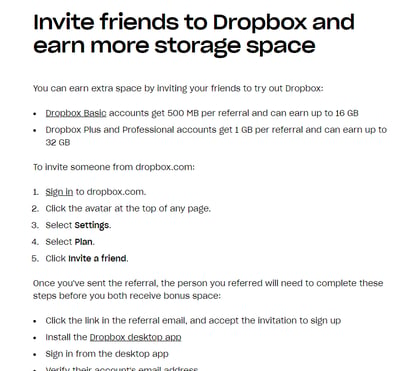
How to make it work for you
2. Acorns

How to make it work for you
3. Stitch Fix
How to make it work for you
4. T-Mobile
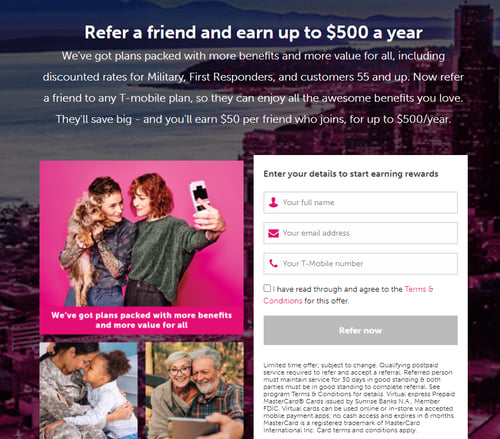
How to make it work for you
5. Glossier
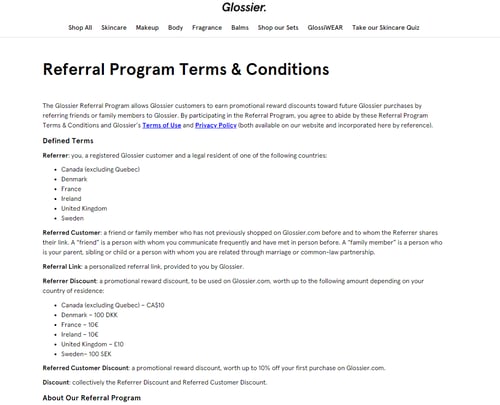
How to make it work for you
6. Healthy Paws
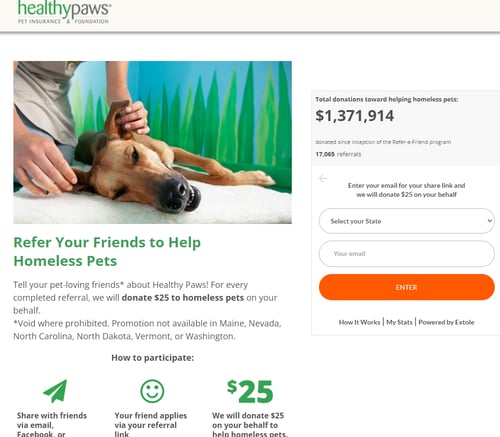
How to make it work for you
7. MeUndies
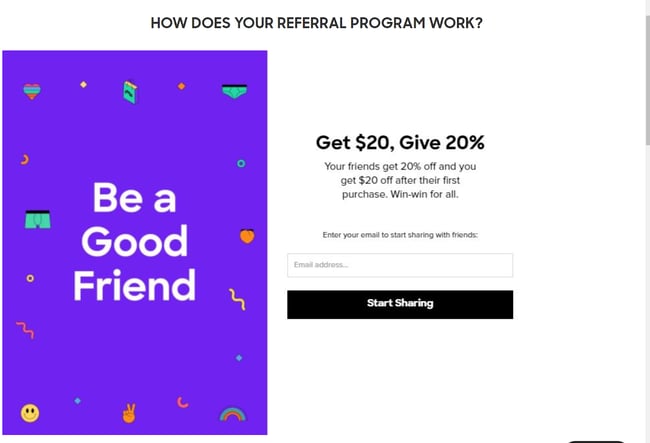
How to make it work for you
8. Google Workspace

How to make it work for you
9. Tesla
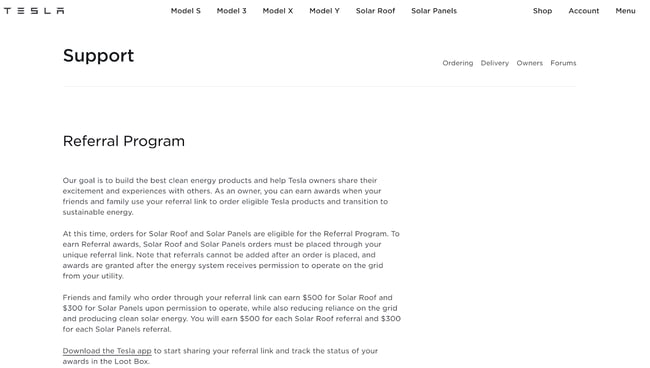
How to make it work for you
10. DoorDash
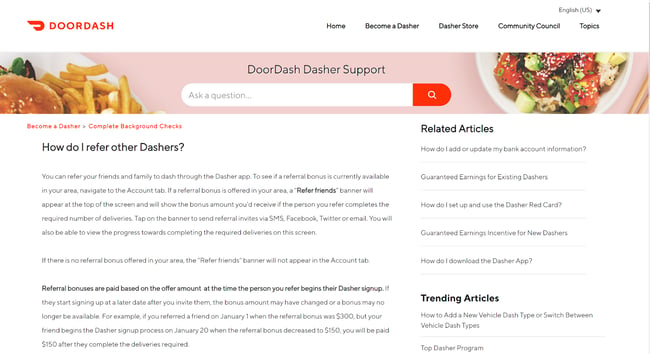
How to make it work for you
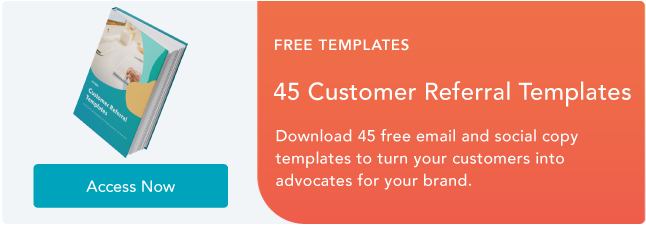

Originally published Nov 15, 2021 5:00:00 PM, updated November 16 2021
How To Make A Referral
Source: https://blog.hubspot.com/service/customer-referral-program
Posted by: lottwasso1969.blogspot.com

0 Response to "How To Make A Referral"
Post a Comment